Team Chat Apps: The Central Hubs for Collaborative Success
A team chat app is a software solution designed to enhance real-time communication and collaboration within teams. These apps serve as central hubs where messages, files, and ideas can be exchanged, thus streamlining workflows and boosting team productivity.
Key Functionalities:
- Instant Messaging: Facilitate swift conversations, questions, and updates among team members.
- Group Chats: Create specific channels for different projects, departments, or topics to foster focused discussions.
- File Sharing: Easily share documents, images, videos, and other files within the team chat for collaborative work.
- Video Conferencing: Some apps come with built-in video conferencing features for face-to-face virtual meetings.
- Integrations: Connect the team chat app with other tools like project management software or cloud storage for a unified workflow.
- Search Functionality: Quickly find past conversations, files, and any shared information within the chat.
- Task Management: Some apps have features that allow you to assign tasks, track progress, and meet deadlines.
- Mobile Access: Access the team chat app from smartphones or tablets for communication on the go.
Benefits of Using a Team Chat App:
- Improved Communication: Real-time chat enables quicker communication compared to email, keeping the team synchronized.
- Enhanced Collaboration: A centralized place for sharing messages, files, and ideas facilitates collaborative work and brainstorming.
- Increased Productivity: Easier communication and access to information save time and streamline workflows.
- Transparency and Accountability: Team discussions and project progress are visible to all, promoting transparency and accountability.
- Improved Team Morale: Enhanced communication promotes a more connected and engaged team environment.
- Accessibility and Flexibility: Team members can access information and collaborate from anywhere with an internet connection.
Examples of Team Chat Apps:
The list below includes some of the most popular team chat apps along with a few additional options:
- Slack: Known for its user-friendly interface and extensive app integrations.
- Microsoft Teams: Ideal for Microsoft Office users with seamless integration.
- Discord: Often used by gaming communities for its real-time chat and voice features.
- Google Chat: Integrates with other Google Workspace products and provides a familiar interface for Gmail users.
- Flock: Features a clean and focused interface, well-suited for smaller teams.
- Twist: Prioritizes focused work by threading conversations and minimizing distractions.
Choosing the best team chat app depends on your specific needs and team size. Consider factors like budget, desired features, and compatibility with your existing tools before making a decision.
The 12 Best Team Chat Apps for Work in 2024
Here are our picks for The 12 Best Team Chat Apps for Work in 2024.
1. Slack: The Team Chat Powerhouse
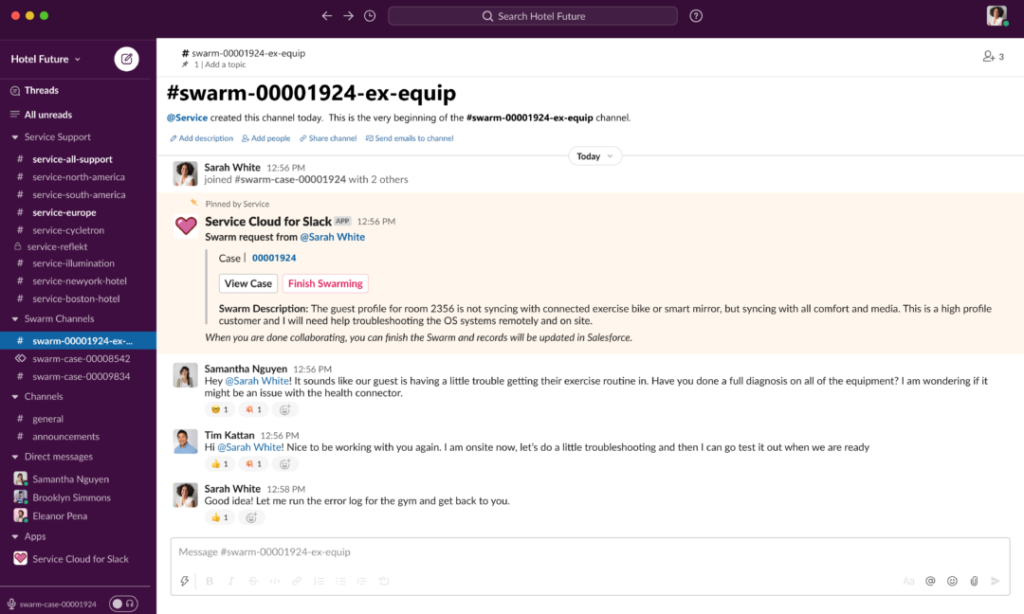
Slack is arguably the most popular team chat application globally, and for good reason. It offers a user-friendly interface, a robust feature set, and extensive integrations, making it a powerful tool for boosting team communication and collaboration. Here’s a detailed breakdown of Slack’s key features:
Communication Features:
- Channels: Create public or private channels for specific projects, departments, or topics. This keeps conversations organized and focused.
- Direct Messages: Send private messages to individual team members or create private groups for focused discussions.
- Threaded Conversations: Conversations branch out into threads for clear organization and easy follow-up on specific points.
- Voice & Video Calls: Integrate voice and video calls directly within Slack, eliminating the need to switch between applications.
- Screen Sharing: Share your screen during calls for presentations, demos, or real-time collaboration.
Collaboration Features:
- File Sharing: Easily drag-and-drop files of various formats into chats or channels for team access and collaboration.
- Integrations: Slack integrates with a vast library of third-party applications, allowing you to connect your favorite tools for a unified workflow. (e.g., project management apps, cloud storage, code repositories)
- @mentions: Mention specific team members or channels to get their attention and keep them informed.
- Reactions: Use emojis to react to messages, providing quick feedback and fostering a more engaging communication style.
- Search Functionality: Powerful search functionality allows you to find past conversations, files, and information shared within Slack.
Customization and Management:
- Roles & Permissions: Assign different roles and permissions to users for granular control over access and functionalities within Slack.
- Workspaces: Create separate workspaces for different projects, teams, or clients to avoid information overload.
- Customization: Customize the look and feel of Slack with themes, emojis, and custom integrations.
- Guest Accounts: Grant temporary access to external collaborators through guest accounts.
Additional Features:
- Apps: Explore and install additional apps within Slack to extend its functionalities, like creating polls, managing tasks, or automating workflows.
- Bots: Utilize bots for various tasks, such as scheduling meetings, summarizing conversations, or integrating with other services.
- Slack Calls: Make calls directly from Slack, either voice-only or video calls, without needing additional software.
Benefits of Using Slack:
- Improved Team Communication: Real-time chat fosters quicker communication and information sharing compared to email.
- Enhanced Collaboration: Centralized file sharing, threaded conversations, and integrations streamline collaborative work.
- Increased Productivity: Easier communication and access to information saves time and streamlines workflows.
- Transparency and Accountability: Team discussions and project progress are readily visible, promoting transparency and accountability.
- Improved Team Morale: Enhanced communication fosters a more connected and engaged team environment.
Things to Consider:
- Free vs Paid Plans: Slack offers a free plan with limited features. Paid plans offer increased storage, integrations, and functionalities.
- Learning Curve: While user-friendly, Slack offers a wide range of features that may require some initial exploration for new users.
Slack is a powerful tool for teams of all sizes, but it’s important to choose the plan that best suits your team’s needs and budget. If you’re looking for a user-friendly and feature-rich team chat app to boost communication and collaboration, Slack is definitely worth considering.
2. Microsoft Teams: Seamless Collaboration for the Microsoft Ecosystem
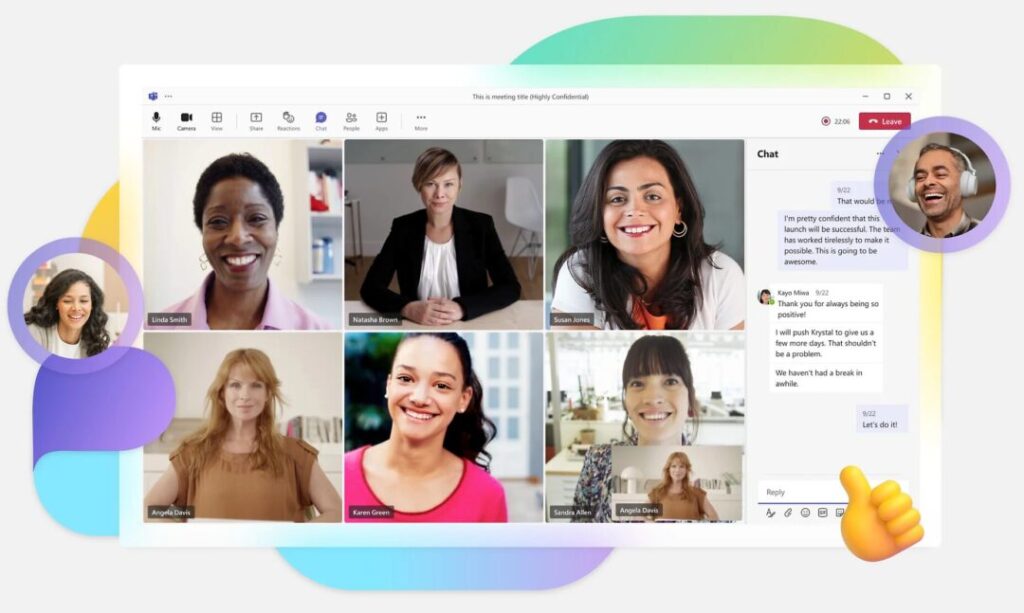
Microsoft Teams is a unified communication and collaboration platform designed specifically for businesses that already use Microsoft 365 products and services. It integrates seamlessly with your existing Microsoft tools, offering a central hub for team communication, file sharing, meetings, and project management.
Key Features:
- Chat: Real-time chat allows for instant messaging with individuals or groups.
- Channels: Create dedicated channels for specific projects, departments, or topics, keeping conversations organized and focused.
- Meetings & Video Conferencing: Schedule and host online meetings with video conferencing capabilities, screen sharing, and recording options.
- File Sharing & Collaboration: Share and collaborate on documents, spreadsheets, presentations, and other files directly within Teams. Users can co-author documents in real-time with integrated Microsoft Office applications.
- Integrations: Teams integrates with a wide range of Microsoft products and services, like OneDrive, SharePoint, Planner, and Power BI, for a unified workflow within the Microsoft ecosystem. You can also install third-party apps to extend functionality.
- Tasks & Planner: Assign tasks directly within Teams and use the built-in Planner integration to track progress and manage projects.
- Calls: Make voice and video calls directly from Teams, eliminating the need to switch between applications.
- Live Annotations: Collaborate on documents and whiteboards in real-time with live annotations during calls or meetings.
- Security & Compliance: Microsoft Teams leverages the security and compliance features of Microsoft 365, ensuring data privacy and regulatory adherence for businesses.
Benefits for Microsoft Users:
- Seamless Integration: Integrates seamlessly with existing Microsoft 365 tools and services, offering a familiar and unified user experience.
- Enhanced Collaboration: Real-time co-authoring of documents, project management tools, and integrated communication features streamline collaboration.
- Improved Productivity: Centralized hub for communication, file sharing, meetings, and tasks reduces context switching and saves time.
- Centralized Management: Manage user accounts, security settings, and access controls within the Microsoft 365 admin console for a unified approach.
Who should consider Microsoft Teams?
- Teams that already use Microsoft 365 and want a communication platform that integrates seamlessly with their existing tools.
- Businesses with a focus on security and compliance who value the robust security features of Microsoft products.
- Project-based teams that can benefit from integrated task management and collaboration features.
Things to Consider:
- Learning Curve: While user-friendly, the variety of features might require some exploration for new users unfamiliar with the Microsoft interface.
- Cost: Microsoft Teams is included in some Microsoft 365 business subscription plans, but additional features might require separate licensing.
Overall, Microsoft Teams is a powerful team chat app that offers a comprehensive communication and collaboration suite, especially for businesses heavily invested in the Microsoft ecosystem.
3. Discord: Communication Hub for Engaged Communities
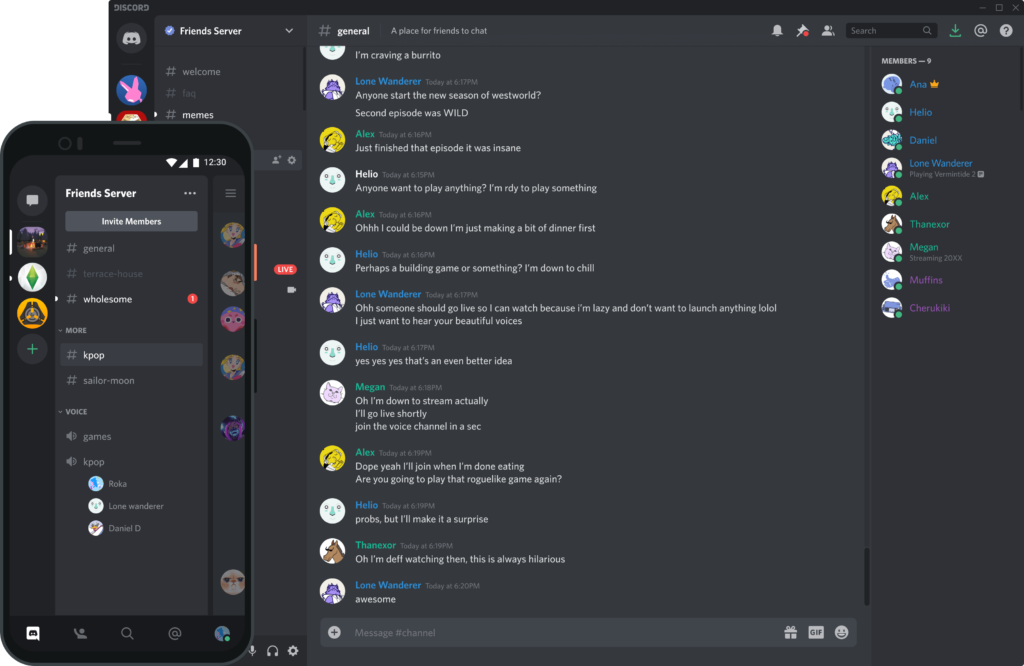
Discord might not be the first name that comes to mind when thinking of traditional business communication tools, but it has carved out a unique space as a team chat app. Discord rose to prominence in the gaming world, offering a feature-rich platform for real-time chat, voice communication, and community building. However, its functionality extends beyond gaming, making it a suitable option for creative teams, project-based groups, and even some business communication needs that prioritize a more informal and interactive environment.
Core Strengths:
- Real-time Chat & Voice Communication: Discord excels at real-time communication with low latency voice chat, text channels, and video calls. This fosters a more interactive and engaging communication style compared to traditional email.
- Persistent Voice Channels: Unlike other platforms where voice calls need to be initiated, Discord offers persistent voice channels that users can join and leave at their convenience, keeping conversations flowing.
- Server Organization: Create and organize servers for different projects, communities, or teams. Each server can have dedicated text channels and voice channels for focused discussions.
- Screen Sharing: Share your screen with other users during voice or video calls for presentations, demonstrations, or collaborative work.
- File Sharing: Share files directly within chat channels, allowing for easy collaboration and access to project materials.
- Customization & Roles: Customize your server with roles and permissions to assign different levels of access and control to users.
- Integrations: Integrate Discord with various third-party tools and services to extend functionalities, such as project management apps, code repositories, or music streaming services.
- Lightweight & Fast: Discord is known for its lightweight design and fast performance, even on less powerful devices.
Who should consider Discord?
- Remote and Distributed Teams: Discord’s focus on real-time communication and persistent voice channels can be valuable for geographically dispersed teams.
- Creative & Project-based Teams: The interactive nature and persistent voice channels can foster brainstorming, idea sharing, and collaboration in creative or project-based environments.
- Communities & Online Groups: Discord’s server structure and organization features are well-suited for managing online communities, fan groups, or similar gatherings.
Things to Consider:
- Informal Environment: Discord’s relaxed and customizable interface might not be ideal for all professional communication needs requiring a more formal tone.
- Limited Integrations: While integrations are available, the selection might not be as vast as some business-oriented team chat apps.
- Security & Privacy: For businesses handling sensitive information, it’s crucial to evaluate Discord’s security features and ensure they meet your specific needs.
Overall, Discord offers a unique blend of real-time communication, community building features, and a lightweight design. It’s a strong option for teams that value a more interactive and engaging communication style, particularly in creative or project-based environments.
4. Google Chat: Seamless Communication within the Google Workspace
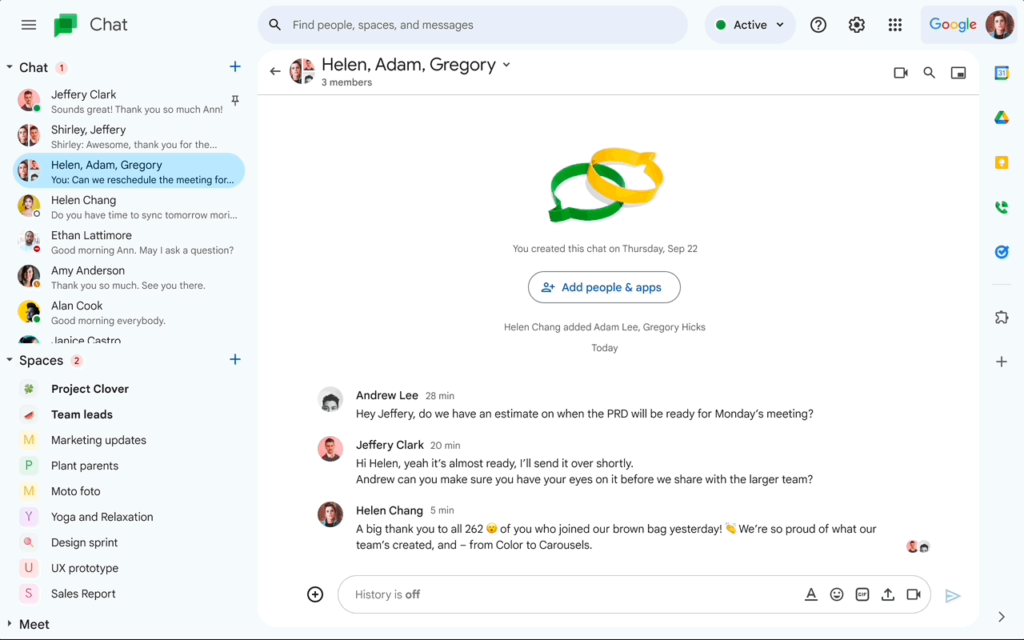
Google Chat is a strong contender for the “best team chat app” title, especially for teams already invested in the Google Workspace ecosystem. It offers a familiar and user-friendly interface that integrates seamlessly with other Google products like Gmail, Drive, and Calendar, streamlining communication and workflow for Google Workspace users. Here’s a breakdown of Google Chat’s key features:
Communication Features:
- Instant Messaging: Real-time chat allows for instant messaging with individuals or groups, fostering quick communication and collaboration.
- Direct Messages & Group Chats: Create private chats with individual team members or dedicated group chats for specific projects or teams.
- Rich Text Formatting: Format messages with bold, italics, underline, and code snippets for better readability and clarity.
- Emoji Reactions: React to messages with emojis to provide quick feedback and add a touch of personality to communication.
- File Sharing: Easily share files stored in Google Drive directly within chat messages, allowing for team collaboration on documents, spreadsheets, presentations, and more.
- Search Functionality: Search through past chat history to find specific messages, files, or information shared within Google Chat.
Integration with Google Workspace:
- Seamless Integration: Integrates effortlessly with other Google Workspace applications like Gmail, Calendar, Drive, Docs, Sheets, Slides, and Meet. You can access and manage chats, files, and meetings directly within these tools.
- Shared Spaces: Create “Spaces” which combine chat functionality with features from other Workspace apps like shared documents, tasks, and video meetings, fostering collaborative work within a central hub.
- Meeting Scheduling: Schedule meetings directly within Google Chat and integrate them with Google Calendar for seamless event management.
Additional Features:
- Mobile Access: Access Google Chat from your smartphone or tablet for on-the-go communication and collaboration.
- Offline Functionality: Limited offline functionality allows you to view past messages and even compose messages offline, which will be sent upon reconnection.
- Security & Compliance: Leverages Google Workspace’s security infrastructure to ensure data privacy and meet industry compliance standards.
Benefits of Using Google Chat:
- Improved Communication: Real-time chat fosters quicker communication and information sharing compared to email, especially within the Google Workspace environment.
- Enhanced Collaboration: Integrations with other Google Workspace tools streamline workflows and centralize collaboration efforts.
- Increased Productivity: Easy access to chat, files, meetings, and tasks within a familiar interface saves time and reduces context switching.
- Familiar Interface: For Google Workspace users, the interface is clean, intuitive, and feels like an extension of the existing tools they already use.
Who should consider Google Chat?
- The team has made significant investments in the Google Workspace ecosystem.
- Businesses prioritizing a familiar and user-friendly interface for their communication needs.
- Teams that value the tight integration and collaboration features offered by Google Workspace tools.
Things to Consider:
- Limited Features: Compared to some other team chat apps, Google Chat might have a more limited set of features, especially for advanced communication or project management needs.
- Scalability: For very large teams or complex projects, Google Chat might not offer the same level of scalability and customization as some enterprise-grade solutions.
Overall, Google Chat is a powerful and user-friendly team chat app for businesses already using Google Workspace. It offers seamless communication, tight integration with other Google tools, and a familiar interface that boosts collaboration and productivity. However, for teams with advanced communication needs or complex project management requirements, it might be worth exploring other options.
5. Flock: Streamlined Communication for Focused Teams
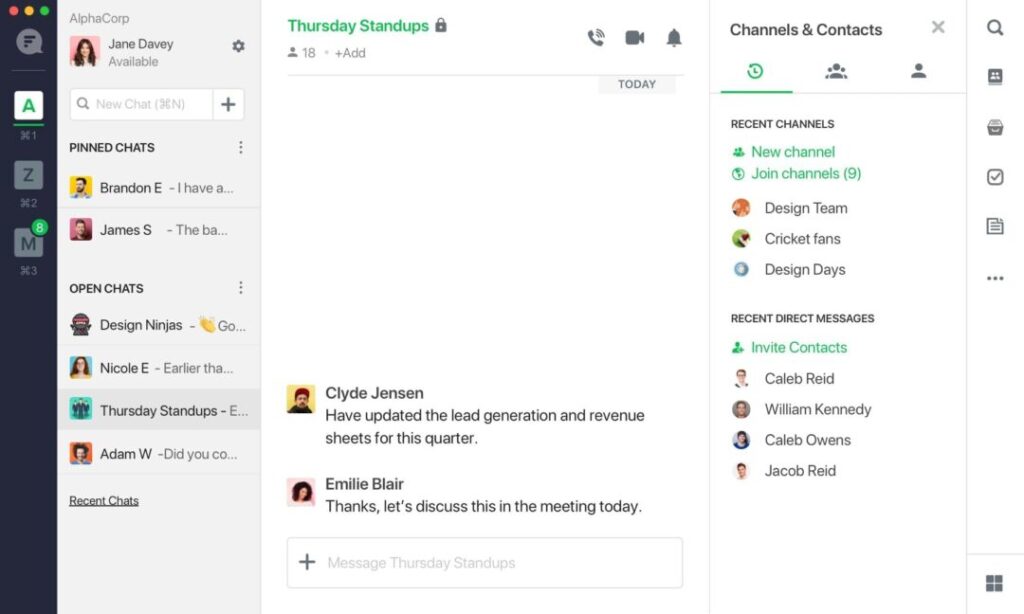
Flock positions itself as a team chat app designed for focused communication and streamlined workflows. It offers a clean and user-friendly interface that prioritizes clarity and organization, making it a strong choice for teams that value simplicity and efficiency. Let’s delve into the key features of Flock:
Communication Features:
- Channels: Create dedicated channels for specific projects, teams, or topics, keeping conversations organized and clutter-free.
- Direct Messages: Send private messages to individual team members or create private groups for focused discussions.
- Guest Accounts: Grant temporary access to external collaborators through guest accounts, ensuring secure collaboration on projects.
- Search Functionality: Powerful search allows you to quickly find past conversations, files, and information shared within Flock.
- @mentions: Mention specific team members or channels to get their attention and keep them informed.
- Video & Voice Calls: Integrate Flock with popular video conferencing services like Zoom or Google Meet for face-to-face communication within the platform (availability might depend on the plan).
- Polls & Votes: Conduct quick polls and gather team feedback directly within chats, streamlining decision-making processes.
Focus and Organization:
- Shared To-Do Lists: Create and manage shared to-do lists within channels, keeping track of tasks and deadlines collaboratively.
- Notes & Reminders: Take notes during conversations and set reminders to ensure follow-up on important points.
- Read Receipts & Typing Indicators: See if your messages have been read and who is currently typing, fostering better communication awareness.
- Pinned Messages: Pin important messages or documents to the top of channels for easy reference.
Collaboration Features:
- File Sharing: Drag-and-drop files directly into chats or channels for team access and collaboration.
- Integrations: Flock integrates with various third-party applications, such as project management tools, cloud storage services, and productivity apps, extending its functionalities.
- Task Management: Some Flock plans offer basic task management features like assigning tasks and due dates.
Security and Administration:
- Admin Controls: Manage user accounts, permissions, and data security settings for centralized control.
- Compliance Features: Flock offers features for data encryption and export to comply with industry regulations (availability might depend on the plan).
Who should consider Flock?
- Teams that prioritize a clean and organized communication environment.
- Small to medium-sized businesses that value a user-friendly interface and basic collaboration features.
- Teams that need occasional video conferencing capabilities but don’t require it for every interaction.
Things to Consider:
- Limited Free Plan: The free plan has limitations on features, storage, and integrations. Upgrading might be necessary for most teams.
- Focus on Simplicity: While Flock offers some collaboration features, it might not be as comprehensive as project management-oriented team chat apps for complex workflows.
- Video Conferencing Integration: Native video conferencing might not be available in all plans, requiring integration with separate services.
Overall, Flock is a solid team chat app for teams seeking a clean, focused, and user-friendly communication platform. Its emphasis on organization and basic collaboration features can streamline workflows, particularly for smaller teams that don’t require extensive project management tools.
6. Twist: Threaded Conversations for Focused Work
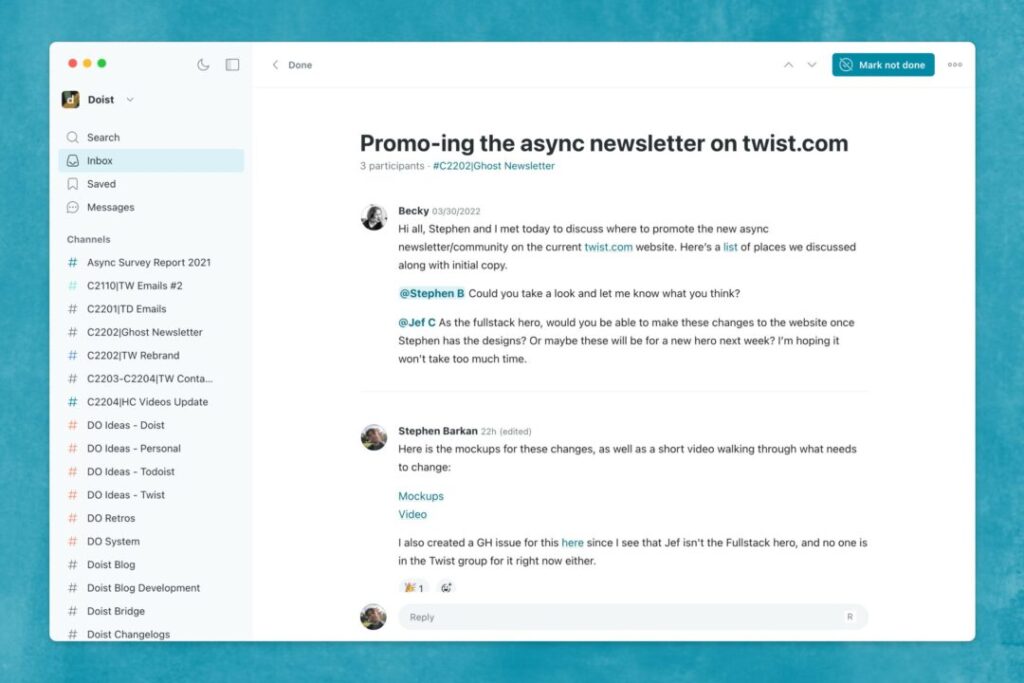
In the fast-paced world of team chat, Twist offers a unique approach. It prioritizes focused work and asynchronous communication through threaded conversations, aiming to reduce distractions and information overload. Here’s a closer look at Twist’s features and why it might be the perfect fit for specific teams:
Focus on Asynchronous Communication:
- Threads: Conversations branch out into focused threads, allowing for clear organization and in-depth discussions on specific topics.
- Direct Messages: Send private messages to individual team members for focused communication on specific matters.
- “Do Not Disturb” Mode: Minimize distractions by enabling “Do Not Disturb” mode to focus on tasks without chat notifications.
- Scheduled Sending: Schedule messages to be sent at specific times, ensuring they reach team members when they’re most likely to be engaged.
- Read Receipts & Unreads: See if your messages have been read and track unread messages for follow-up.
Collaboration Features:
- File Sharing: Drag-and-drop files directly into threads for team access and collaboration.
- Integrations: Twist offers a limited selection of integrations with some project management and cloud storage services.
- Tasks & Reminders: Convert messages into actionable tasks with due dates and assign them to team members, promoting accountability.
- Search Functionality: Powerful search allows you to find past conversations, files, and information shared within Twist.
- @mentions: Mention specific team members or channels to get their attention and keep them informed within threads.
Team Management:
- Channels: Create dedicated channels for specific projects, teams, or topics, but with a focus on threaded discussions within channels.
- Guest Accounts: Grant temporary access to external collaborators through guest accounts for secure project collaboration.
- Admin Controls: Manage user accounts, permissions, and data security settings for centralized control.
Who should consider Twist?
- Teams that value focused work and asynchronous communication to avoid constant interruptions.
- Knowledge workers and creative teams who benefit from in-depth threaded discussions on specific topics.
- Teams that already use project management tools for complex workflows and primarily rely on Twist for focused communication.
Things to Consider:
- Limited Real-time Communication: Twist prioritizes asynchronous communication, so it might not be ideal for teams requiring extensive real-time chat or instant updates.
- Limited Integrations: While some integrations are available, the selection is not as vast as some other team chat apps.
- Learning Curve: The threaded conversation style might require a slight adjustment for teams accustomed to traditional chat formats.
Overall, Twist offers a refreshing approach to team communication. By prioritizing focused work and asynchronous discussions, it allows teams to delve into topics thoroughly without information overload. This can be particularly beneficial for knowledge workers, creative teams, and those who value deep dives into specific subjects.
7. Pumble: Feature-Rich Communication Hub with Freemium Options
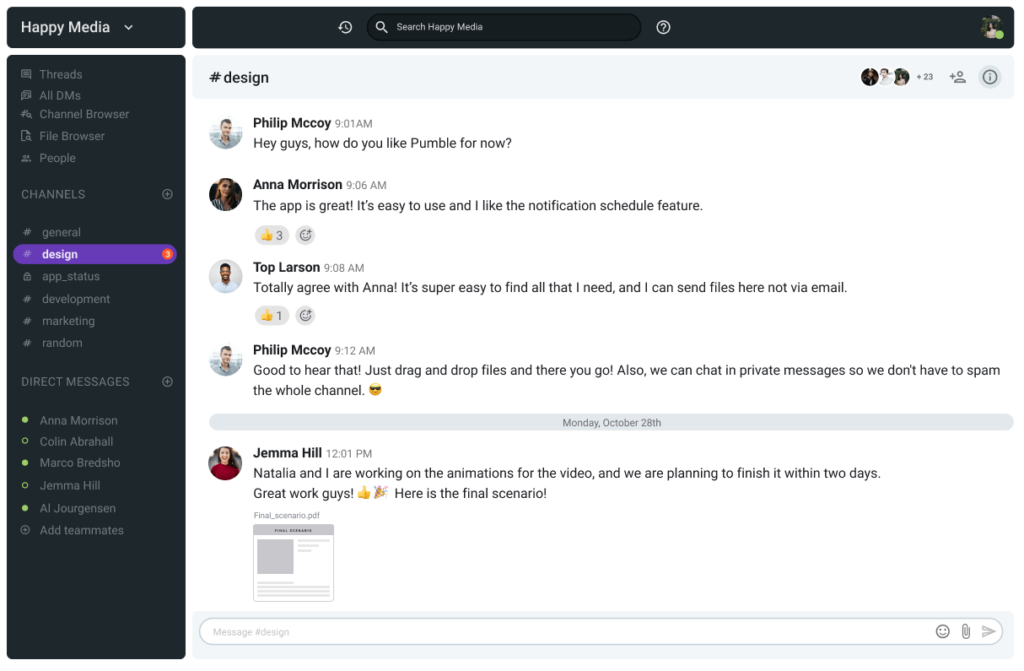
Pumble positions itself as a feature-rich team chat application with a strong emphasis on user-friendliness and affordability. It offers a freemium model, making it an attractive option for teams of all sizes, along with a robust feature set that caters to various communication and collaboration needs. Here’s a breakdown of Pumble’s key features:
Communication Features:
- Channels: Create public or private channels for specific projects, departments, or topics, allowing for organized communication.
- Direct Messages: Initiate private chats with individual team members or create private groups for focused discussions.
- Threads: Break down conversations into threaded discussions for clear organization and easy follow-up on specific points. This offers a balance between Twist’s focus on threads and a more traditional chat format.
- Real-time Chat: Pumble facilitates real-time communication with instant messaging, keeping teams connected and fostering quick information sharing.
- Mentions: Use @mentions to notify specific team members or channels, ensuring they’re aware of relevant discussions.
Collaboration Features:
- File Sharing: Drag-and-drop files directly into chats or channels for team access and collaboration.
- Integrations: Pumble integrates with various third-party tools and services, such as Google Drive, Dropbox, Trello, and Zapier, extending its functionality for different workflows.
- Tasks & Reminders: Assign tasks directly within Pumble, set due dates, and receive reminders to keep projects on track (availability might depend on the plan).
- Search Functionality: Search through past conversations, files, and information shared within Pumble to find what you need quickly.
Additional Features:
- Video & Voice Calls: Initiate video and voice calls directly within Pumble, eliminating the need to switch between applications (availability might depend on the plan).
- Screen Sharing: Share your screen during calls for presentations, demonstrations, or real-time collaboration.
- Guest Access: Grant temporary access to external collaborators through guest accounts, maintaining security for sensitive projects (availability might depend on the plan).
- Polls & Votes: Conduct quick polls and gather team feedback directly within chats, streamlining decision-making processes (availability might depend on the plan).
Free vs Paid Plans:
Pumble offers a generous free plan with unlimited users, message history, and file storage up to 10GB. Paid plans unlock additional features like video conferencing, guest access, increased storage, and advanced integrations.
Who should consider Pumble?
- Teams looking for a feature-rich and user-friendly platform with a free plan for basic needs.
- Teams of all sizes, from small startups to large enterprises, with plans to accommodate different requirements.
- Teams that value a balance between real-time communication and threaded discussions for focused work.
Things to Consider:
- Limited Free Plan Features: While the free plan is attractive, some valuable features like video conferencing and guest access require paid subscriptions.
- Learning Curve: With a wide range of features, exploring Pumble’s full potential might require some initial familiarization for new users.
Overall, Pumble is a strong contender in the team chat app market. Its freemium model, user-friendly interface, and comprehensive feature set make it a versatile solution for various communication and collaboration needs.
8. Element: Secure Messaging with Decentralized Power
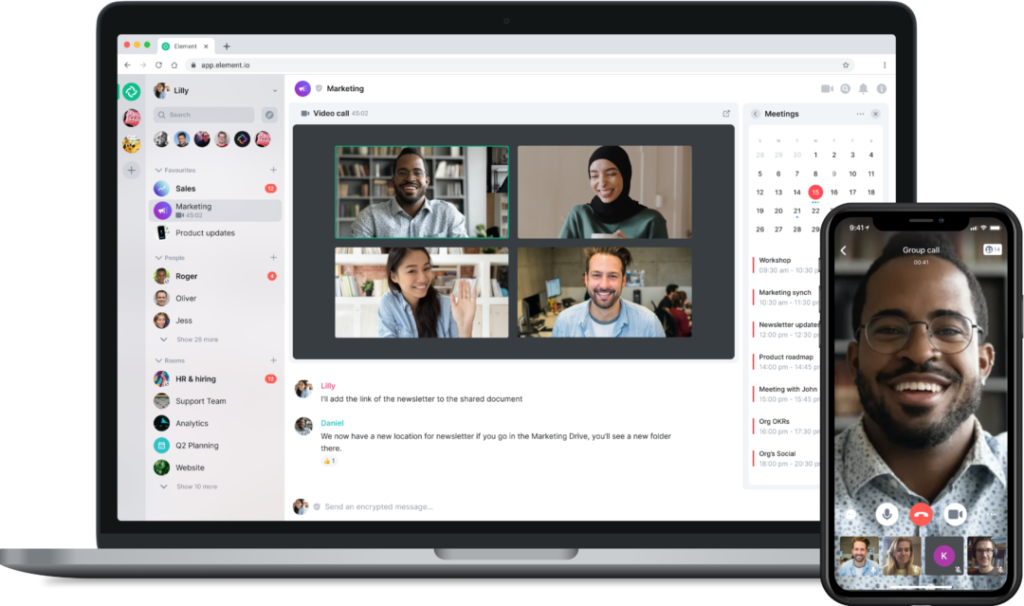
Element stands out in the team chat landscape for its focus on security and a unique decentralized approach. It leverages the Matrix protocol, allowing for communication across different servers and platforms while prioritizing user privacy and data control. The functionality provided by Element is detailed below:
Security and Privacy:
- End-to-End Encryption: All communication in Element is end-to-end encrypted by default, ensuring only authorized users can access messages.
- Cross-Signing: Verifies the identities of users you communicate with, adding an extra layer of security against impersonation.
- Decentralized Network: Unlike traditional chat apps with centralized servers, Element operates on the Matrix network, distributing data across multiple servers for increased security and resilience.
- Open Source: Element’s underlying code is open-source, allowing independent scrutiny and fostering trust in its security practices.
Communication Features:
- Channels: Create public or private channels for specific projects, teams, or topics, keeping conversations organized.
- Direct Messages: Engage in private chats with individual team members or create private groups for focused discussions.
- Real-time Chat: Facilitate real-time communication with instant messaging, keeping teams connected and up-to-date.
- Voice & Video Calls: Make voice and video calls directly within Element, eliminating the need for separate applications (availability might depend on the server you connect to).
- File Sharing: Share files directly within chats or channels for team collaboration.
Additional Features:
- Bridges: Connect to other communication networks like IRC or Slack through bridges, allowing communication with users on different platforms.
- Guest Access: Grant temporary access to external collaborators through guest accounts on some servers (availability depends on server settings).
- Customization: Element offers some customization options for the interface and notification settings.
Who should consider Element?
- Teams that prioritize strong security and data privacy for their communications.
- Teams that value an open-source approach and transparency in the underlying technology.
- Users who already have accounts on other Matrix-based servers and want a unified communication platform.
Things to Consider:
- Decentralized Nature: The decentralized approach can mean slightly less centralized control for administrators compared to some traditional team chat apps.
- Server Selection: Choosing the right server to connect to can impact features and user experience. Some features might not be universally available across all servers.
- Learning Curve: Understanding the decentralized nature and potential server variations might require a bit more initial setup compared to some user-friendly team chat apps.
Overall, Element offers a unique proposition for security-conscious teams and those who value an open-source approach. Its decentralized network and end-to-end encryption prioritize data privacy and control. However, the decentralized nature requires some additional considerations regarding server selection and feature availability.
9. Mattermost: Self-Hosted Option with Customization and Control
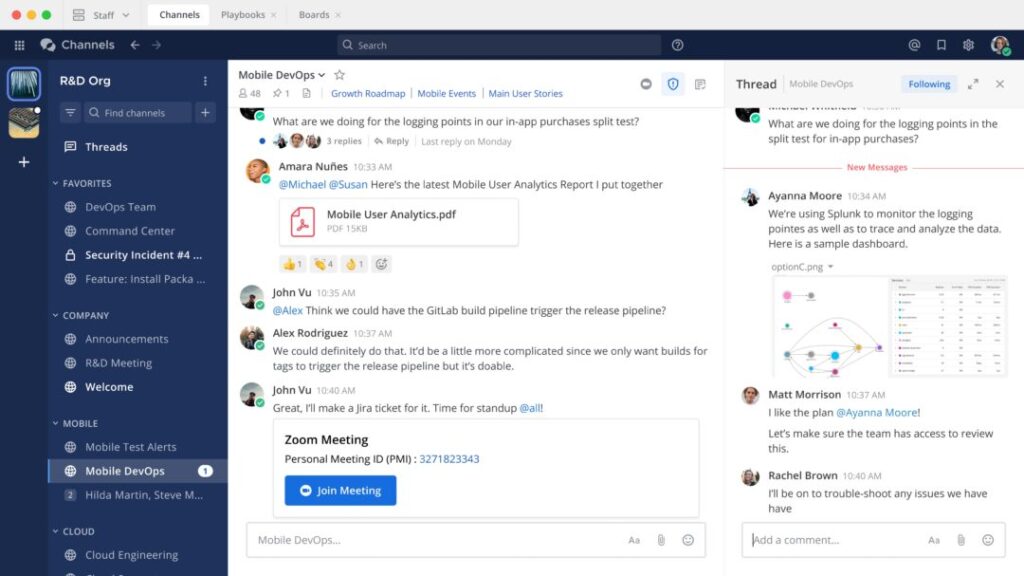
Mattermost stands out for its self-hosted deployment option, offering businesses greater control over data security and customization. It provides a robust feature set for real-time communication, collaboration, and project management, making it a suitable choice for teams seeking an alternative to cloud-based solutions.
Core Features:
- Real-time Chat: Facilitate instant messaging with individuals or groups, fostering quick communication and collaboration.
- Channels: Create public or private channels for specific projects, departments, or topics, keeping conversations organized and focused.
- Direct Messages: Engage in private chats with individual team members or create private groups for focused discussions.
- Threaded Conversations: Conversations branch out into threads, allowing for clear organization and easy follow-up on specific points.
- File Sharing: Drag-and-drop files directly into chats or channels for team access and collaboration on documents, spreadsheets, presentations, and other formats.
- Integrations: Mattermost integrates with various third-party tools and services, extending its functionality for different workflows (availability might depend on the self-hosted environment).
- @mentions: Mention specific team members or channels to get their attention and keep them informed within threads or channels.
- Search Functionality: Search through past conversations, files, and information shared within Mattermost to find what you need quickly.
Self-Hosting Benefits:
- Security & Compliance: Self-hosting allows businesses to store data on their own servers, potentially enhancing data security and compliance with specific regulations.
- Customization: Mattermost offers greater customization options for the user interface, integrations, and workflows compared to some cloud-based solutions.
- Control & Scalability: Self-hosting provides more control over user management, data access, and server scalability to accommodate growing teams.
Additional Features (availability might depend on configuration):
- Video & Voice Calls: Integrate video and voice conferencing functionalities for face-to-face communication within the platform.
- Task Management: Implement basic task management features like assigning tasks, setting deadlines, and tracking progress (through plugins or integrations).
- Guest Access: Grant temporary access to external collaborators through guest accounts on some self-hosted deployments (configuration required).
Who should consider Mattermost?
- Businesses with strict data security or compliance requirements that prefer self-hosting their communication platform.
- Teams that value customization and want to tailor the platform to their specific workflows.
- Organizations with large teams or complex communication needs that require scalability and control over their chat infrastructure.
Things to Consider:
- Self-Hosting Challenges: Self-hosting requires technical expertise for server maintenance, software updates, and security management.
- Integration Complexity: Integrating Mattermost with third-party tools might require more technical knowledge compared to cloud-based solutions with pre-built integrations.
- Limited Free Plan: The free plan has limitations on features and users. Upgrading might be necessary for most teams.
Overall, Mattermost offers a powerful and customizable self-hosted team chat solution. It empowers businesses with greater control over data security, customization, and scalability. However, the self-hosting aspect requires technical expertise for maintenance and integration, making it a better fit for teams with the resources to manage it effectively.
10. Troop Messenger: Secure Communication for Businesses with a Focus on Control
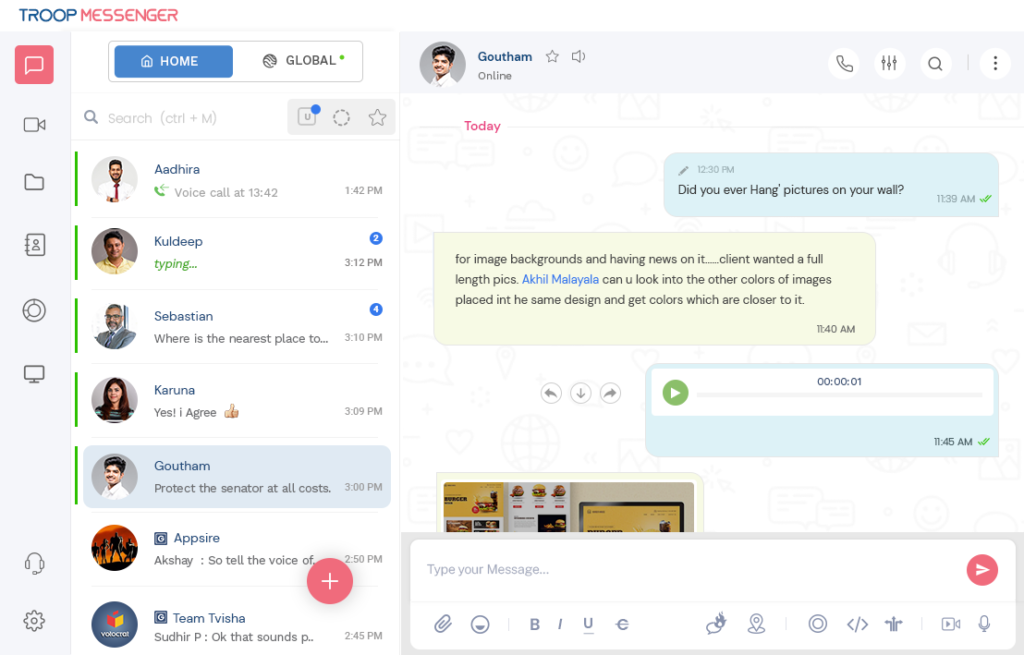
Troop Messenger positions itself as a secure team chat application designed specifically for businesses. It emphasizes features that cater to internal communication, collaboration, and data security, making it a strong option for organizations seeking a controlled environment for team interactions. Here’s a breakdown of Troop Messenger’s key features:
Communication and Collaboration Features:
- Real-time Chat: Facilitate instant messaging with individuals or groups, fostering quick communication and information sharing.
- Channels: Create public or private channels for specific projects, departments, or topics, keeping conversations organized and focused.
- Direct Messages: Initiate private chats with individual team members or create private groups for focused discussions.
- File Sharing: Share files of various formats like documents, spreadsheets, presentations, and images directly within chats or channels for team collaboration.
- Audio & Video Calling: Schedule or initiate ad-hoc audio and video calls directly within Troop Messenger, eliminating the need to switch between applications (availability might depend on the plan).
- Screen Sharing: Share your screen during calls or conferences for presentations, demonstrations, or real-time collaboration.
- Tasks & Planning: Assign tasks directly within Troop Messenger and utilize basic planning features to track progress and manage projects (availability might depend on the plan).
Security and Control:
- Military-Grade Encryption: Troop Messenger leverages AES-256 encryption to safeguard chats, calls, conferences, and files, ensuring data privacy.
- Data Security Features: Additional security features like LDAP/SSO integration, multi-factor authentication, and data residency options can be implemented to meet specific compliance requirements (availability might depend on the plan).
- Admin Controls: Manage user accounts, permissions, data access, and security settings for centralized control over team communication.
- On-Premise Deployment: Troop Messenger offers an on-premise deployment option, allowing businesses to host the software on their own servers for maximum control over data security (availability might depend on the plan).
Additional Features:
- Live Annotations: Collaborate on documents or whiteboards with real-time annotations during calls or meetings (availability might depend on the plan).
- Location Sharing (Optional): Share your current location with team members if required for specific workflows (features can be disabled for privacy).
- Customizable Interface: Customize the platform’s interface to match your company branding (availability might depend on the plan).
Who Should Consider Troop Messenger?
- Businesses prioritizing data security and control over their team communication platform.
- Organizations with compliance requirements that necessitate features like on-premise deployment and advanced data security options.
- Teams that require built-in task management functionalities alongside their communication needs (availability might depend on the plan).
Things to Consider:
- Learning Curve: The variety of features might require some exploration for new users to become familiar with the platform.
- Focus on Security: Troop Messenger’s emphasis on security features might come at the expense of a simpler, more user-friendly interface compared to some other team chat apps.
- Plan Availability: Some advanced features like on-premise deployment, task management, and live annotations might be limited to specific plans or require additional costs.
Overall, Troop Messenger is a secure and feature-rich team chat solution designed for businesses. It offers strong data security features, control over deployment options, and functionalities tailored for internal communication and collaboration. However, the focus on security might lead to a slightly steeper learning curve, and some advanced features might require higher-tier plans.
11. Ryver: Streamlined Communication and Built-in Task Management
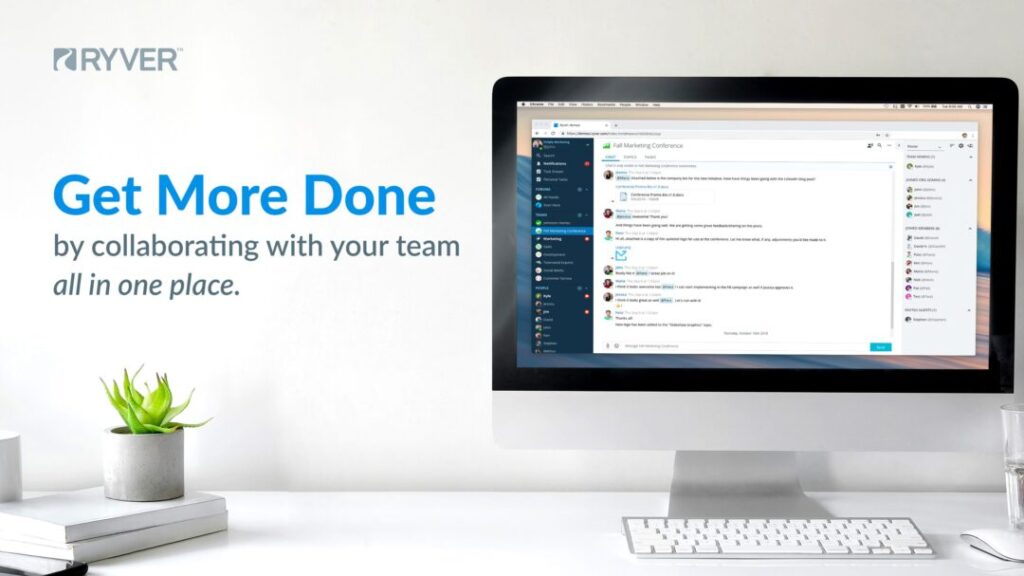
Ryver positions itself as a multi-functional team chat app that goes beyond just communication. It integrates task management features directly into the platform, aiming to streamline workflows and centralize collaboration for teams. Here’s a closer look at Ryver’s key features:
Communication Features:
- Channels: Create public or private channels for specific projects, departments, or topics, keeping conversations organized and focused. This allows for focused communication within the broader team chat platform.
- Direct Messages: Initiate private chats with individual team members or create private groups for focused discussions.
- Real-time Chat: Facilitate instant messaging with individuals or groups, fostering quick communication and information sharing.
- @mentions: Mention specific team members or channels to get their attention and keep them informed within threads or channels.
- File Sharing: Drag-and-drop files directly into chats or channels for team access and collaboration on documents, spreadsheets, presentations, and other formats.
- Search Functionality: Search through past conversations, tasks, files, and information shared within Ryver to find what you need quickly.
Task Management Features:
- Kanban Boards: Visualize tasks using Kanban boards, allowing teams to track progress through different stages (to-do, in progress, done).
- Task Assignment & Due Dates: Assign tasks to specific team members, set due dates, and track progress within the chat platform.
- Task Discussions: Discuss tasks directly within the assigned task, keeping communication and context centralized.
- File Attachments: Attach relevant files to tasks for easy access by team members working on them.
Collaboration Features:
- Video & Voice Calls: Integrate video and voice conferencing functionalities for face-to-face communication within the platform (availability might depend on the plan).
- Screen Sharing: Share your screen during calls or conferences for presentations, demonstrations, or real-time collaboration.
- Integrations: Ryver integrates with various third-party tools and services, extending its functionality for different workflows (availability might depend on the plan).
Additional Features:
- Team Calendar: Share and manage team schedules within the platform, fostering better coordination and visibility.
- Polls & Surveys: Conduct quick polls and gather team feedback directly within chats, streamlining decision-making processes.
- Notes & Checklists: Create and share notes or checklists within channels or tasks for better organization and information sharing.
Who Should Consider Ryver?
- Teams that value a unified platform for both communication and task management, aiming to centralize collaboration efforts.
- Project-based teams that benefit from visual task management tools like Kanban boards.
- Businesses looking for a team chat app that goes beyond basic communication and offers built-in task management functionalities.
Things to Consider:
- Learning Curve: While user-friendly, the combination of communication and task management features might require some initial familiarization for new users.
- Task Management Depth: Compared to dedicated project management tools, Ryver’s task management features might be less comprehensive for very complex workflows.
- Limited Free Plan: The free plan has limitations on features, storage, and users. Upgrading might be necessary for most teams to utilize the full potential.
Overall, Ryver offers a compelling solution for teams seeking a unified platform for team chat and task management. Its Kanban boards, task assignment features, and centralized communication channels streamline workflows and foster collaboration. However, teams with highly complex project management needs might require additional tools, and the free plan has limitations.
12. Chanty: Streamlined Communication and Tasks Flowing Seamlessly
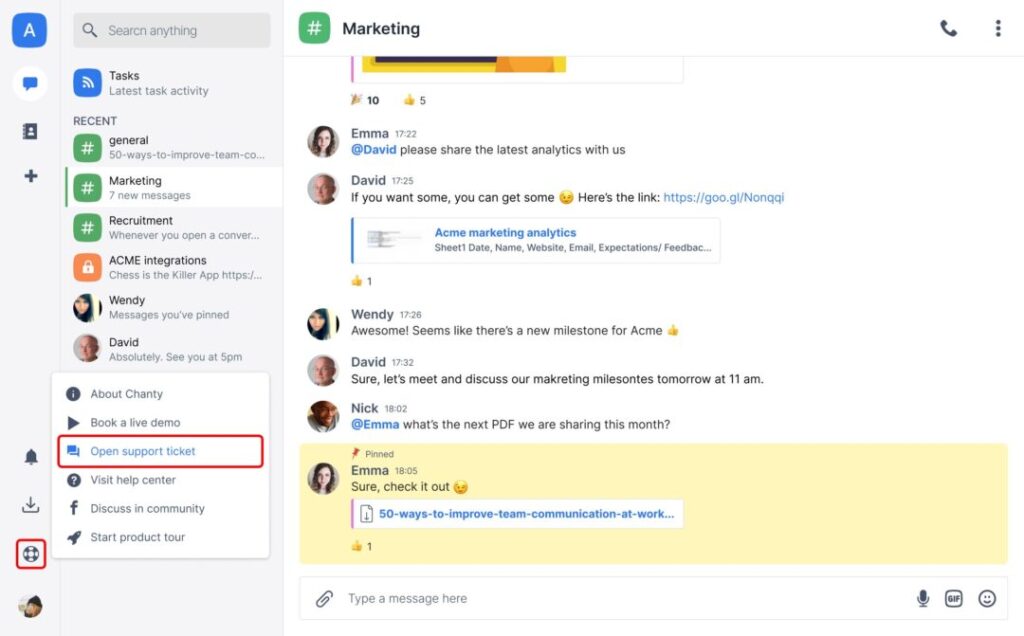
Chanty stands out for its user-friendly approach to team chat, emphasizing clear communication and effortless task management within a single platform. Here’s a closer look at the features that make Chanty a strong contender for your team’s collaboration needs:
Communication Features:
- Real-time Chat: Facilitate instant messaging with individuals or groups, fostering quick information sharing and keeping teams connected.
- Channels: Create organized structures for communication by establishing public or private channels dedicated to specific projects, departments, or topics.
- Direct Messages: Initiate private chats with individual team members or create private groups for focused discussions on sensitive matters.
- @mentions: Efficiently grab the attention of specific team members or channels by mentioning them within threads or channels.
- Unlimited Searchable Message History: Access your entire chat history, even on the free plan, ensuring past information and decisions are readily available for reference.
- File Sharing: Drag-and-drop files directly into chats or channels for team access and collaboration on documents, spreadsheets, presentations, and various other file formats.
Effortless Task Management:
- Tasks from Messages: Chanty shines in its ability to seamlessly convert any message into an actionable task. This eliminates the need for separate to-do lists and centralizes project management within the chat platform.
- Task Assignment & Due Dates: Assign tasks directly to team members, set due dates, and track progress within the chat interface, fostering accountability and transparency.
- Kanban Board View: Visualize tasks using a Kanban board, allowing teams to see the progress of tasks through different stages (to-do, in progress, done). This provides a clear understanding of workflow and helps prioritize tasks effectively.
- Task Discussions: Keep communication and context centralized by discussing tasks directly within the assigned task. This eliminates the need to switch between platforms for discussions and updates.
Additional Features:
- Audio & Video Calls (New Feature!): Chanty recently added audio and video conferencing functionalities, allowing for face-to-face communication directly within the platform.
- Screen Sharing: Share your screen during calls or conferences for presentations, demonstrations, or real-time collaboration, enhancing communication and understanding.
- Teambook: This central location acts as a knowledge hub, offering easy access to all tasks, conversations, pinned messages, and files. This promotes information retrieval and keeps everything organized for future reference.
- Integrations: Chanty integrates with various third-party tools and services, extending its functionality for different workflows (availability might depend on the plan).
Who Should Consider Chanty?
- Teams that value a user-friendly and intuitive chat interface for quick communication and information sharing.
- Project-based teams that benefit from the ease of converting messages into tasks and the Kanban board view for clear task visualization and management.
- Businesses looking for a cost-effective solution, with the free plan offering unlimited message history and core functionalities.
Things to Consider:
- Limited Free Plan Features: While the free plan is generous, features like audio/video calls and advanced integrations might require upgrading for larger teams with more complex needs.
- Task Management Depth: Compared to dedicated project management tools, Chanty’s task management features might be less comprehensive for very complex workflows.
- Focus on Simplicity: Chanty prioritizes a user-friendly experience, so it might lack some advanced features found in more feature-rich team chat apps.
Overall, Chanty offers a well-rounded solution for teams seeking a balance between clear communication and streamlined task management. Its user-friendly interface, built-in task functionality, and free plan with unlimited message history make it an attractive option for various team needs.
Conclusion: Choosing the Perfect Team Chat App
The landscape of team chat apps is brimming with possibilities, each offering unique features and functionalities. From the security-focused control of Troop Messenger to the all-in-one convenience of Ryver, the ideal solution depends on your team’s specific needs and priorities.
Consider the following factors when making your choice:
- Team size and structure: Larger teams might require features for user management and control, while smaller teams might prioritize user-friendliness.
- Communication style: Does your team rely heavily on real-time chat, threaded discussions, or video conferencing?
- Integration needs: Does your team use other productivity tools that require seamless integration?
- Security and compliance requirements: For sensitive information, features like data encryption and on-premise deployment might be crucial.
- Budget: Team chat apps offer various pricing models, from free plans with limited features to comprehensive paid subscriptions.
By carefully evaluating these factors alongside the strengths of each app explored in this article, you can make an informed decision and select the team chat app that empowers your team to collaborate effectively and achieve success in 2024 and beyond. Remember, the best team chat app is the one that seamlessly integrates into your existing workflows, fosters clear communication, and streamlines collaboration for your unique team dynamic.



